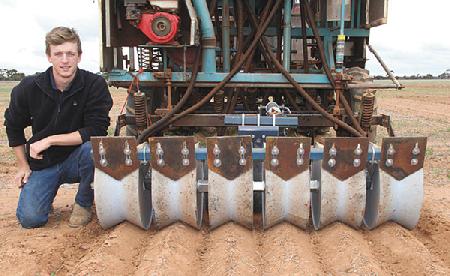 "In our area we can't count on regular rainfall, and certainly not enough to always grow a decent crop," says Australian farmer Callum Wesley. He solved the problem by inventing the Wesley Wheel, which captures moisture and channels it right down to the growing plants. Wesley says it's a very effective way to make more efficient use of the moisture they get.
"In our area we can't count on regular rainfall, and certainly not enough to always grow a decent crop," says Australian farmer Callum Wesley. He solved the problem by inventing the Wesley Wheel, which captures moisture and channels it right down to the growing plants. Wesley says it's a very effective way to make more efficient use of the moisture they get.
Wesley's device uses specially designed tillage points combined with trailing metal wheels shaped in a "V". The wheels press the soil into a triangular raised bed row. Between the raised soil is a shallow furrow that collects water as it runs off the raised beds. The steep incline encourages water runoff into a center channel, where it seeps into the soil, around the roots of the planted crop. Wesley said the machine was tested at 2 Australian locations in 2012 and 2013 and it showed that 26 percent yield gains were made with 18-in. row spacing. Trials of the Wesley Wheel are continuing in Australia this year.
Wesley is a third generation wheat belt farmer and consultant with the Department of Agriculture. He came up with the concept when he was just 16 and initially tested it on a 4-row small scale machine. With that rig he planted a 10-acre test plot on his family farm and compared the yield results with other fields using conventional tillage. His plot produced about 70 bu. per acre, which was about 25 percent better than conventionally tilled fields.
Wesley has adapted his wheels onto a 50-ft. wide planting rig that his family farm uses to plant about 5,000 acres of wheat. The machine places wheat seed in 35 rows spaced 18 in. apart.
Wesley says his aim is to make the wheels adaptable to existing tillage and planting systems used on level land that receives minimal rainfall or is typically irrigated. Wesley is now focused on expanding tests of the wheel across Australia's wheat belt.
Contact: FARM SHOW Followup, Callum Wesley, Southern Cross, Australia (twitter: @Callum_Wesley).
1-800-834-9665
New Tillage Implement Conserves Crop Moisture
FARM SHOW Magazine » New Tillage Implement Conserves Crop Moisture
New Tillage Implement Conserves Crop Moisture
